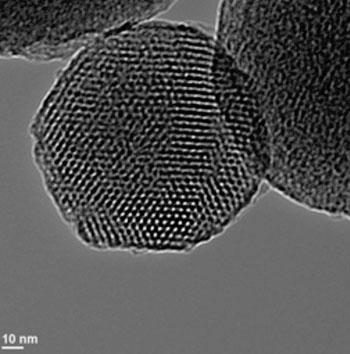Silica-Based Nanoparticles Selectively Kill Lung Cancer Cells
By LabMedica International staff writers
Posted on 17 Mar 2015
A novel approach to the selective delivery of toxic chemotherapeutic agents is based on nanoparticles that sequester the drug until it is liberated by the action of specific proteases that are present in a high concentration inside lung cancer cells.Posted on 17 Mar 2015
Investigators at the German Research Center for Environmental Health (Munich, Germany) constructed the nanoparticles—basically extremely small open-ended boxes—from mesoporous silica (containing pores with diameters between two and 50 nanometers) tightly capped at each end by avidin molecules linked by proteins sensitive to the action of the protease MMP9 (matrix metalloproteinase 9). The nanoparticles were loaded with the cancer drug cisplatin, which was safely sequestered as long as the avidin-protein caps remained intact.

Image: TEM (transmission electron micrograph) of a mesoporous silica nanoparticle (Photo courtesy of Wikimedia Commons).
The justification for use of these nanoparticles was the fact that the protease MMP9 was overexpressed in tumors. It was known to enhance the metastatic potency of malignant cells and had been associated with poor prognosis of lung cancer.
The investigators studied the impact of cisplatin-containing nanoparticles on mouse tumors in vivo and on mouse and human lung tumors being grown in novel ex vivo three-dimensional lung tissue cultures.
They reported in the February 22, 2015, online edition of the journal ACS Nano that the MMP9-mediated release of cisplatin induced apoptotic cell death only in lung tumor regions of Kras mutant mice without causing toxicity in tumor-free areas or in healthy mice. The MMP9-responsive nanoparticles also allowed for effective combinatorial drug delivery of cisplatin and the proteasome inhibitor bortezomib, which had a synergistic effect on the therapeutic efficiency. The concentration of MMP9 in healthy lung tissue was too low to destroy the nanoparticles' protective layer and the drugs remained sequestered inside the nanocarriers.
"Using these nanocarriers we can very selectively release a drug such as a chemotherapeutic agent specifically at the lung tumor," said senior author Dr. Silke Meiners, a group leader at the German Research Center for Environmental Health. "We observed that the drug's effectiveness in the tumor tissue was 10 to 25 times greater compared to when the drugs were used on their own. At the same time, this approach also makes it possible to decrease the total dose of medicines and consequently to reduce undesirable effects."
Related Links:
German Research Center for Environmental Health




 assay.jpg)








